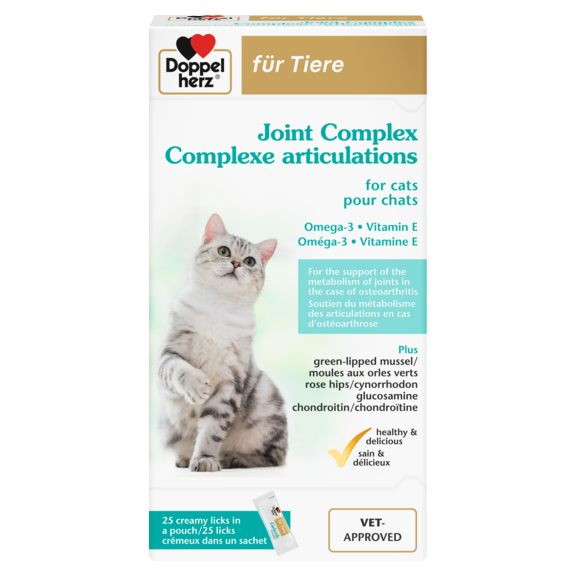But why is the cat so mobile? It is because the individual vertebral bones in its spine are not as rigidly connected as in humans or even dogs. But of course the cat's movements are also based on the perfectly coordinated interplay of muscles and nerves, bones and tendons, connective tissue and ligaments. The joints play a central role in this because, as movable connections between two bones, they cushion the effects of pressure, whereby they are sometimes exposed to great forces.
The key to healthy joints is healthy growth. Kittens should be fed food that is specially adapted to their age and needs. This is because a healthy musculoskeletal system contributes to a healthy and long cat life full of joie de vivre and vitality. As the decisive framework in the body, it is responsible for mobility and stability. Keeping it healthy is the basis for your cat's quality of life.
Elementary building blocks of the musculoskeletal system
As perfectly constructed as the joints are, they still represent weak points in the cat's locomotor system. Because once they have been damaged by ageing, overweight or accidents, the body can no longer fully restore them. In order to alleviate the disease process or to prevent joint diseases from occurring, the cat should take in important building blocks, which it needs for the structure and function of the musculoskeletal system, through the diet. These ingredients can then be broken down by the metabolism and rebuilt into bones, tendons, ligaments and muscles or needed for these processes.
Nine out of ten cats over the age of 12 have degenerative changes in their joints. This number is alarmingly high and surprising because cats often do not show us their pain. And even one third of younger cats already suffer from chronic joint diseases.
In order to enable the cat to move smoothly and without pain, the muscles, cartilage and tissue should be maintained and supported in their function through exercise and valuable nutrients in the diet.
Joint structure of the cat
The cat's skeleton is adapted to its way of life as a hunter. Its bones are light and strong. By the way, it has about 40 more bones than humans. Most of them are in the skull, the spine and the tail.
The various joints of the cat differ in terms of their structure and mobility. But the rough components of each joint are largely the same.
Most cat joints consist of:
- Synovial fluid (synovia)
- Articular cartilage
- Bones
- Joint capsule
A joint consists of the condyle and the socket, which fit on and into each other like two pieces of a jigsaw puzzle. Both are covered by articular cartilage, which serves as a "shock absorber". The synovial fluid or synovial fluid (synovia) fills the cavity ("joint space") and prevents abrasion. It nourishes the joint cartilage and reduces friction in the joint. The joint capsule is a tight connective tissue that surrounds the entire joint. The surrounding muscles give it stability.
In the course of a cat's life, the cartilage structures are broken down through wear and tear. However, through healthy nutrition and species-appropriate exercise, these can be regenerated by the body itself. With normal stress and a healthy joint, the build-up and breakdown is usually in balance. However, in an old or overweight cat, as well as through injuries or overloading, it can get out of balance. In this case, a diet with high doses of ingredients such as omega-3 fatty acids, vitamin E, green-lipped mussel, rosehip, chondroitin and glucosamine can help to support the musculoskeletal system and joint processes.
Joint types of the cat
Joints are differentiated according to the number of joint-forming bones. There are simple and compound joints. Simple joints connect two bones at a time, while compound joints connect more than two (e.g. elbow joint).
Another possibility for classification is the shape of the joint surfaces. These are subdivided and named according to their appearance: Ball joint, Nut joint, Ellipsoidal joint, Saddle joint and Roller joint.
Furthermore, the different joints can be distinguished according to their function: There are hinge joints, spiral joints, screw joints, snap joints and slide joints.
And last but not least, joints can be divided into incongruent and tight. In incongruent joints, the joint surfaces do not fit together exactly, so that separate cartilage discs are needed (for example, in the meniscus in the knee joint). And in tight joints, possible movements are limited by very tight ligaments (for example in the tarsus joint, the carpal joint).
As you can see, the topic of joints and mobility is very extensive and important for your cat. We hope you enjoy reading - and wish your pet a healthy and long life together with you!

